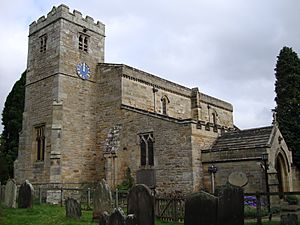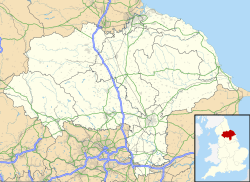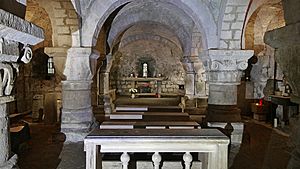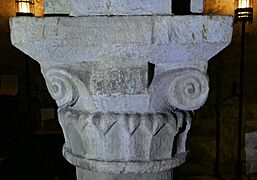Church of St Mary, Lastingham facts for kids
Quick facts for kids Church of St Mary, Lastingham |
|
|---|---|
| St Mary's Church | |

Church of St Mary, Lastingham
|
|
| 54°18′16″N 0°52′57″W / 54.3045°N 0.8826°W | |
| OS grid reference | SE727904 |
| Location | Lastingham, North Yorkshire |
| Country | England |
| Denomination | Church of England |
| History | |
| Status | Active |
| Founded | 654 |
| Founder(s) | St Cedd |
| Dedication | St Mary the Virgin |
| Past bishop(s) | St Cedd St Chad |
| Architecture | |
| Style | Norman Perpendicular |
| Years built | 1078–1086 |
| Administration | |
| Parish | Lastingham |
| Benefice | Lastingham with Appleton-le-Moors and Rosedale |
| Deanery | Northern Ryedale |
| Archdeaconry | Cleveland |
| Diocese | York |
The Church of St Mary, Lastingham, is a special church in the small village of Lastingham in North Yorkshire, England. It's part of the Church of England. This church is located about 4 miles (6.4 km) north of Kirkbymoorside and 6 miles (9.7 km) west of Pickering. It's also about 30 miles (48 km) northeast of the city of York.
The very first church here was a Catholic monastery built in 654. The church you see today was mostly built much later, in the late 1000s. It became an Anglican church during the Reformation, a time when many churches in England changed from Catholic to Anglican. Lastingham has been an important place for Christian history in Northern England. Many people visit it, especially to see its rare crypt. This crypt is said to be unique in England, and maybe even the world, because of its special design.
Contents
History of the Church
The famous historian Venerable Bede wrote about how monks started a wooden monastery at a place called Lastingeau in 654. This name meant "the home of Læ̃sta's people." The land for the monastery was given by the King of Deira. The monks built their home in a quiet valley within the Yorkshire Moors.
The First Abbot: St Cedd
St Cedd was the first leader, or abbot, of this monastery. He sadly died from the plague at Lastingham in 664. At first, he was buried outside. But later, the monks built a church around his burial spot. There are no parts of this first church left today. It's thought that it was destroyed during attacks over the next 400 years, especially by Viking invaders from Denmark.
When St Cedd passed away, his brother, St Chad, became the abbot. However, St Chad soon moved to Lichfield. Over time, many of St Cedd's belongings and remains from Lastingham were moved to Lichfield to be kept with his brother's. Some of their bones are now in Birmingham's Catholic Cathedral. But many people believe that most of St Cedd's remains are still buried at Lastingham.
Rebuilding the Monastery
The original monastery was likely destroyed around 870. But in 1078, William the Conqueror allowed a new church to be built on the same spot. A group of Benedictine monks from Whitby started this new church under a leader named Stephen. However, they only stayed for ten years before moving to York. People later thought they moved because the abbey was very remote, and the area was quite wild and dangerous.
Because the monks only stayed for a clear decade, the church shows a strong Romanesque style from that time. It's quite rare to know the exact start and end dates for the building of such an old church. The church was originally Catholic. But after the dissolution of the monasteries during the Reformation, it came under the control of the Church of England.
Church Design and Changes
Over the years, the Church of St Mary has been changed and added to.
Architectural Styles and Features
In the 1200s, parts like the arcades (rows of arches), bays (sections of the church), and aisles (side passages) were added to the north and south sides. In the 1300s, the church tower was built. For about 500 years after that, not much work was done.
Then, in 1879, a famous architect named John Loughborough Pearson renovated the church. He rebuilt the porch (the entrance area) and put a new roof on the whole church. Because of these changes, the church now has a mix of building styles. The walls of the aisles are in the Perpendicular style, which is a later English Gothic style. But the nave (the main part of the church where people sit) and most of the foundations and the crypt are in the older Norman style.
Some people have found ancient stone altars in the church. Experts believe these altars might date back to Roman times and were later reshaped during the Anglo-Saxon period.
The Unique Crypt
One of the most amazing parts of St Mary's is the crypt, which is a room built underground. Its walls are very thick, about 3 feet (0.91 m) wide. This crypt is famous because it's believed to be the only one in England that has a nave, an apse (a rounded end), and side aisles, just like a church above ground. It's also thought to be the oldest Norman crypt in the world with this kind of layout.
The crypt is located directly under the entire church above it. It has a square pillar with a piscina (a basin used for washing sacred vessels). Four strong pillars support the crypt. Historians think these pillars might be even older than the Norman period, possibly from before the Norman Conquest. It's believed that the crypt hasn't been changed much since the time of William the Conqueror. You can get into the crypt by going down a staircase from the nave.
Many experts and writers have praised the church's architecture and history. The famous art historian Pevsner called the crypt "unforgettable." The poet John Betjeman said St Mary's is "one of the most moving places in England." Simon Jenkins, in his book England's Thousand Best Churches, gave the church four out of five stars. He wrote that while "most churches are a challenge to the faithful, Lastingham is a challenge to the faithless." Jenkins also noted that the church doesn't have many fancy decorations or old artifacts, saying,
Lastingham has few furnishings of interest. It does not need them.
- Church of Saint Mary
The Church Community
The Church of St Mary has been the main parish church for Lastingham since at least 1228. For a while, it belonged to St Mary's Abbey in York until 1299. The first official vicar (the priest in charge) for Lastingham is listed in 1314.
Today, the Lastingham church community, also called a benefice, includes four parishes with five churches. These are Christ Church, Appleton-le-Moors, St Gregory in Cropton, St Chad in Hutton-le-Hole, St Mary in Lastingham, and St Mary & St Lawrence in Rosedale Abbey.
See also
- Grade I listed buildings in North Yorkshire (district)
- Listed buildings in Lastingham







